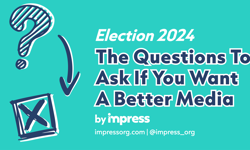The NMA also joined Ofcom and UK broadcasters in calling for independent regulatory oversight of the tech platforms.
In its submission to the Cairncross review into the future of sustainable journalism, the NMA outlined a list of 42 options and initiatives to support Britain’s local, regional and national press, recognised as the backbone of the UK news media sector and by far the biggest investors in news, says the NMA.
Laying out the challenges facing the industry, the NMA said: “The primary focus of concern today is the loss of advertising revenues which have previously sustained quality national and local journalism and are now flowing to the global search engines and social media companies who make no meaningful contribution to the cost of producing the original content from which they so richly benefit.”
Ad revenues for news media publishers, in particular local publishers, have plummeted over the last decade as Google and Facebook have rapidly expanded their dominance of the digital advertising ecosystem. Although they produce no original content, the two companies extract nearly 100 per cent of the growth in digital ad expenditure in the UK, says the NMA.
Despite the drops in revenues, established national and local news brands are reaching bigger audiences overall than they have for decades as people’s appetite for news grows and they are able to consume it on the platform or device of their choice, demonstrating the high public demand for trusted news.
One of the headline solutions proposed by the NMA is the introduction of a “fair, open and equitable” content licence fee agreement, supported by a UK Publishers Right, to ensure that the tech companies pay for the content from which they benefit.
In a separate submission to the review, NLA Media Access – the rights licensing and database business owned by news media publishers – outlined how such a scheme could work, saying that its well-established system for licensing news media content to media monitoring organisations could, in principle, be a possible route for licensing the tech platforms.
News media publishers would be required to meet a series of criteria to be eligible for the scheme including demonstrating the consistent quality of its journalism through, for example, membership of IPSO or adherence to the Editors’ Code of Practice.
The NMA highlighted four key areas to protect journalism:
* Launch a competition inquiry into the dominance of the tech companies and the role of intermediaries in the digital advertising supply chain and their impact on consumers, advertisers and other media players, leading to effective remedies;
* Introduce a fair, open and equitable content licence fee agreement, supported by a UK Publishers Right, enabling the tech companies to demonstrate the value they extract and to pay for the content from which they benefit, without discrimination between news publishers;
* Give the tech companies the same legal responsibility as publishers for the content they carry, unless it is from a bona fide news source, and introduce independent regulatory oversight of their activities. This would incentivise the aggregators to promote verified news content over fake news and other harmful content;
* Ensure greater openness and transparency over algorithms. Require the tech companies to give reasonable notice of any changes to terms of business or to algorithms which impact news publishers, to explain the purpose of the changes and to set out the assumptions and editorial judgments which lie behind the automation.
The NMA added: “Measures of success for the review in 10 years’ time would see a vibrant and well- funded independent news media sector marked by an increase in the number of news media journalists, regular launches of new local titles by dedicated commercial news media companies, and a rebalancing of the advertising market so that revenues follow audiences and advertisers can once again be confident that their brand messages are seen by real people viewing real content in a brand-safe environment.
“Successful solutions would result in search engines and social media companies recognising that genuine news is the vital component of engagement with their platforms and that it is in their long- term interests actively to promote it over fake news and other harmful content.”










